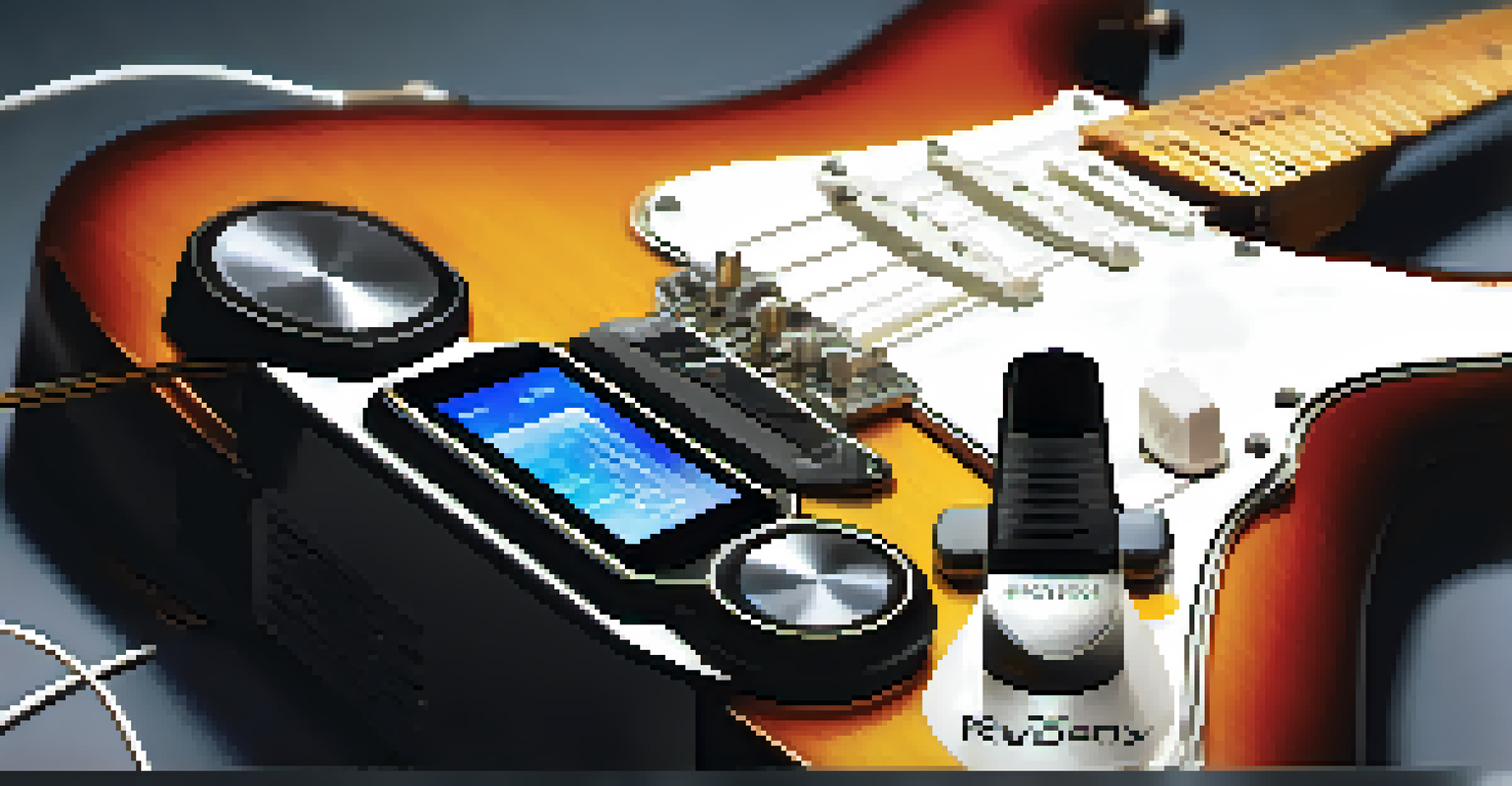Wireless Systems: Freedom for Guitarists in Live Sound

The Evolution of Wireless Systems for Guitarists
Wireless systems have transformed how guitarists perform live, providing unmatched freedom of movement. Gone are the days of being tethered to an amp, which often limited stage presence and creativity. Today’s technology allows musicians to roam freely, engaging with the audience while maintaining sound quality.
The beauty of wireless technology is that it allows musicians to move freely and express themselves in ways that were previously unimaginable.
The shift from wired to wireless began with the need for mobility, and as technology advanced, so did the reliability and audio fidelity of these systems. Early models often faced issues like interference and dropouts, but modern systems use advanced frequency management to minimize these problems. This evolution has empowered guitarists to express themselves more fully on stage.
As a result, many musicians now consider wireless systems essential gear for live performances. They not only enhance the overall experience for both the performer and the audience but also enable guitarists to explore new creative avenues while playing. The evolution of these systems marks a significant milestone in live sound technology.
Benefits of Going Wireless for Performers
One of the most significant benefits of wireless systems is the freedom they provide. Guitarists can move around the stage, interact with bandmates, and connect with fans without the limitations of a cable. This mobility can create a more dynamic performance, making the show more engaging for the audience.

Additionally, wireless systems eliminate the risk of tripping over cables, which can lead to costly accidents or even injuries on stage. They also simplify stage setup, allowing for a cleaner look and reducing clutter. This not only enhances the aesthetic of the performance but also improves safety for everyone involved.
Freedom of Movement on Stage
Wireless systems allow guitarists to move freely, enhancing their performance and audience engagement.
Moreover, the ability to control sound levels and effects remotely adds another layer of versatility. Guitarists can make adjustments mid-performance without needing to rush back to their amp. This flexibility allows for a more polished and professional sound, which is crucial in live music settings.
Choosing the Right Wireless System for Your Needs
When it comes to selecting a wireless system, there are several factors to consider. First, assess your performance environment: a small venue may require different specifications compared to outdoor festivals. Understanding your specific needs will help narrow down your options and ensure you choose a system that meets your requirements.
In today's world, performance is not just about sound; it's about the entire experience, and wireless systems play a crucial role in that.
Another key aspect is the frequency range of the wireless system. Different systems operate on various frequencies, and some may be more prone to interference than others. It's essential to select a system that offers a reliable frequency range suitable for your performance environment to ensure a seamless experience.
Lastly, consider the battery life and range of the wireless system. A system with longer battery life will save you from potential interruptions during a performance, while a greater range allows for more freedom of movement. Investing time in researching these features will ultimately enhance your live performance experience.
Common Misconceptions About Wireless Systems
Despite their many advantages, some guitarists hesitate to switch to wireless systems due to misconceptions. One common myth is that wireless systems compromise sound quality. However, advancements in technology have significantly improved audio fidelity, often matching or even surpassing wired connections.
Another misconception is that wireless systems are too complicated to set up or operate. While this may have been true in the past, most modern systems are user-friendly and come with detailed instructions. Many manufacturers also offer support resources to help users get started, making the transition smoother than ever.
Improved Sound Quality
Modern wireless technology offers audio fidelity that often matches or exceeds that of traditional wired connections.
Lastly, some believe that wireless systems are prohibitively expensive. While there are premium options available, there are also budget-friendly systems that provide excellent performance. This range of choices means that any guitarist can find a wireless solution that fits their needs and budget.
Integrating Wireless Systems into Your Setup
Integrating a wireless system into your existing setup is generally straightforward. Most systems connect easily to your guitar and amplifier, allowing for a quick transition from wired to wireless. It’s as simple as plugging in the transmitter and receiver, and you’re good to go.
Once connected, it's important to test the system before a performance. This testing phase allows you to familiarize yourself with the system's range, battery life, and any potential interference issues. Spending time on this step can prevent technical hiccups during your live show.
Furthermore, consider how you can use the wireless system to enhance your overall performance. Experimenting with movement and stage presence can lead to more engaging shows. Embrace the freedom that comes with wireless systems and use it to elevate your musicianship.
The Role of Wireless Systems in Modern Music Genres
Wireless systems have become integral to various music genres, from rock to jazz and beyond. In rock music, for instance, guitarists often thrive on high energy and movement, and wireless setups allow them to fully embrace that dynamic performance style. This adaptability has made wireless systems a staple in the genre.
In jazz or acoustic settings, musicians value the clarity and freedom that wireless systems provide. They can roam freely to engage with bandmates and the audience, creating a more intimate and immersive experience. The flexibility of wireless systems complements the improvisational nature of these genres.
User-Friendly Options Available
Today’s wireless systems are designed to be easy to set up and operate, with options available for various budgets.
Moreover, electronic and pop artists often use wireless technology to incorporate multiple instruments and effects seamlessly. This allows for creative performances that capture the audience's attention. As music continues to evolve, the relevance of wireless systems remains paramount in enhancing live sound.
Future Innovations in Wireless Guitar Technology
Looking ahead, the future of wireless guitar technology is promising, with innovations on the horizon. As audio technology continues to advance, we can expect even greater sound quality and reliability from wireless systems. This evolution will further empower guitarists to push the boundaries of their performances.
Emerging technologies, such as artificial intelligence and machine learning, are likely to play a role in shaping the next generation of wireless systems. These advancements may lead to smarter frequency management and enhanced user experiences. Imagine a system that automatically adjusts to avoid interference based on the venue and environmental conditions.

Furthermore, the integration of wireless systems with other musical technologies, like MIDI and digital effects, could open up new creative possibilities for guitarists. The future holds exciting potential for musicians, making it an exhilarating time to explore wireless systems and their capabilities.